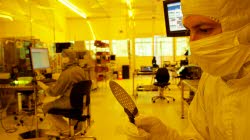
A sensor developed in Norway gives microphones hyper-acute hearing and a sense of direction.
A sensor developed by scientists at SINTEF’s MiNaLab will help to make microphones hypersensitive:
“Think of traditional videoconference equipment. Several people are sitting around the table, but the microphone has been placed where its sound reception is less than optimal.
With technology of this sort, a microphone will be able to “see” where the sound comes from, pick up the voice of the person speaking, and filter out other sources of noise in the room,” explains ICT researcher Matthieu Lacolle, who emphasises that acoustics scientists at SINTEF have also contributed to this innovative solution.
Small but tightly packed
The microphone is packed full of microelectronics. What makes it really special, however, is an optical position sensor that is no more than a millimetre in diameter.
The reason for giving a position sensor such an important role is that a microphone is completely dependent on a membrane, which picks up the pressure waves produced by the sound.
“In principle, a microphone acts like a drum. You have a membrane that vibrates when it is impacted by a sound – which is just a series of pressure waves. And then you have a reference surface in the background. The distance between these two surfaces registers the sound. We do this by measuring light waves from a microscopically small laser, so we can say that the sensor in microphones actually sees the sound,” explains Lacolle.
The sensor can measure incredibly small movements, and thus also extremely quiet sounds. If we make the membrane light enough, and let it oscillate freely in the air, the microphone also becomes directionally sensitive. “That also tells us where the sound is coming from,” says Lacolle, adding that the membrane is only 100 nanometres thick, almost 1000 times thinner than a human hair.
Coloured by light
The technology that makes the microphone so sensitive is based on a combination of two optical phenomena; interference and diffraction, both of which are due to the wave character of light.
“If we hold up a CD to the light, we see the play of colours where it reflects the light. This happens because light consists of a spectrum of wavelengths that the naked eye perceives as colours, and these wavelengths are diffracted in different directions, explains Lacolle.
Another phenomenon that can be utilised to measure sound is interference, which occurs when a number of waves are superimposed on each other. You can observe this when you stand in a harbour where incoming waves are reflected by a pier and are superimposed on top of the waves that follow them into the harbour. Complex, apparently chaotic wave patterns can occur, but so do standing waves, which don’t appear to move at all,” says the SINTEF researcher.
What the SINTEF scientists did was to exploit optical diffraction and interference to measure membrane movements of less than the diameter of an atom by using the optimal sensor.
We have created very special grooved microstructures on the reference surface, which lies directly underneath the microphone membrane. When the laser illuminates these microstructures, we can read off the direction in which the light is reflected by means of photodetectors, which transform the light into electrical signals.”
Laboratory mass-production
The microphone thus consists of several elements: an ultrathin membrane, tiny grooved microstructures, a miniaturised laser and a number of photodetectors. Everything is integrated into a tiny circuit that is mass-produced on a silicon wafer on which all the structures are etched, using special equipment within a clean room.
The Latest Bing News on:
Microphones
- APD to expand ShotSpotter to NE Albuquerqueon May 8, 2024 at 9:29 pm
APD leaders say the costly technology has already reduced gunfire across the city. Data shows the total number of ShotSpotter activations is down 26% from this time last year. But the planned four ...
- Faulty microphones stall Parliament businesson May 8, 2024 at 4:57 pm
THE Senate was forced to prematurely adjourn on Tuesday after microphones at the new Parliament Building in Mount Hampden developed technical faults.... To access this post, you must purchase a ...
- Sennheiser round table experts discuss recording in the wildon May 8, 2024 at 6:56 am
Expert panel give tips about recording techniques using Sennheiser’s MKH line of RF condenser microphones, including the new MKH 8030 ...
- Parliament: Senate business adjourned due to faulty microphoneson May 7, 2024 at 10:17 pm
THE Senate on Tuesday failed to sit for Parliament business due to malfunctioning microphones. Deputy President of the Senate, Hon. Micheal Nyambuya told members that the Hansard could not record due ...
- MEMS microphoneson May 5, 2024 at 5:00 pm
If you like DIY USB microphones, you’re in luck: we’ve featured one based on an STM32 as well as a beautiful recreation of a studio-quality mic.
- The Best Microphones for 2024on May 4, 2024 at 12:00 pm
Whether people are looking for a mic to upgrade their streaming setup or sound better in Discord calls, a quality mic will go a long way.
- I've tested hundreds of microphones, but a special feature puts this one at the top for meon May 4, 2024 at 5:00 am
The Lewitt Ray Aura microphone has distance-sensing technology that is like autofocus, but for your voice. Check them out.
- Shure Releases New Nexadyne Dynamic Vocal Microphoneson May 2, 2024 at 5:00 pm
Available now in cardioid and supercardioid polar patterns, Nexadyne vocal microphones achieve state-of-the-art polar pattern consistency, unparalleled noise reduction, and best-in-class professional ...
- Best microphones for streaming and gaming in 2024on April 30, 2024 at 8:03 am
One of the best microphones for streaming and gaming is essential, I don't care who you are. If you're a streamer trying to attract new viewers, professional sound quality is arguably the most ...
- 'Very disconcerting': Parliament spaces out microphones after interpreter injured by feedbackon April 29, 2024 at 6:36 pm
Last year, the Labour Program found Ottawa was breaking labour laws by not adequately protecting interpreters, following an October 2022 incident in which a parliamentary interpreter was sent to the ...
The Latest Google Headlines on:
Microphones
[google_news title=”” keyword=”microphones” num_posts=”10″ blurb_length=”0″ show_thumb=”left”]
The Latest Bing News on:
Optical position sensor
- Amazon Is Now Selling This Asus Gaming Mouse at Just $19.99on May 7, 2024 at 9:52 pm
Asus has carved out a strong position in the gaming hardware market ... Equipped with an 8000 dpi optical sensor, the TUF Gaming M3 Gen II also delivers great tracking accuracy. Gamers can adjust the ...
- Optical Sensor Market: A Decade of Growth Ahead, Predicted 10% CAGR till 2033on May 1, 2024 at 7:23 pm
In 2022, the global optical sensor market will have grown to about US$ 22 billion. According to Future Market Insights, the industry will be worth $24.2 billion in 2023. The demand for optical sensors ...
- Optical Position Sensor Market Analysis, Key Segments, Share, Size, Growth Status, and Forecast 2024 to 2032on April 28, 2024 at 3:02 pm
The research contains a market overview, geographical breadth, segmentation, and financial performance of main competitors. The research evaluates the current situation of the industry in North ...
- Optical barcodes expand range of high-resolution sensoron April 26, 2024 at 11:27 am
The same geometric quirk that lets visitors murmur messages around the circular dome of the whispering gallery at St. Paul's Cathedral in London or across St. Louis Union Station's whispering arch ...
- Razer’s Viper V3 Pro mouse puts its dongle where it belongson April 23, 2024 at 8:00 am
That’s the most obvious difference Razer is announcing today with its flagship Viper V3 Pro mouse for esports pros and those who aspire to be one. For $160, the new Viper V3 Pro includes the $30 Razer ...
- Best gaming mice 2024: Find your perfect matchon April 18, 2024 at 2:01 am
The high position of the sensor catches your movements ... laser diode to determine positioning. In most cases an optical sensor will do just fine. However, if you plan on using your mouse on ...
- A sensor that can tell you 'where a cable is bent' will be developedon April 12, 2024 at 12:00 pm
the sensor can identify the bending position based on the pattern of the optical signal. The development of these systems, named 'OptiGap,' began with a prototype that combined three filaments ...
- Magnetostrictive Position Sensors Informationon June 28, 2022 at 9:12 am
Analog voltage outputs include 0 - 10V. Sensors that can transmit position data along optical fibers are also available. Measurement range is the full range of travel that can be measured. A single ...
- Optical Triangulation Position Sensors Informationon June 21, 2022 at 1:42 am
The lower the noise the better the resolution. Most optical triangulation position sensors house the sensor itself with the emitter. The sensor detects the beam that is reflected from the surface or ...
- The Prusa I3 MK3S And A Tale Of Two Sensorson October 8, 2020 at 12:15 am
Optical filament sensor from the author’s Prusa i3 MK3 ... the force of two opposing magnets return the lever to its original position. With no springs or mechanical switch to get gummed ...
The Latest Google Headlines on:
Optical position sensor
[google_news title=”” keyword=”optical position sensor” num_posts=”10″ blurb_length=”0″ show_thumb=”left”]










